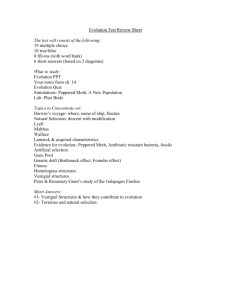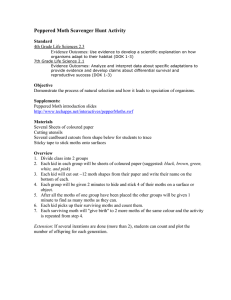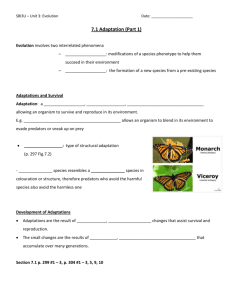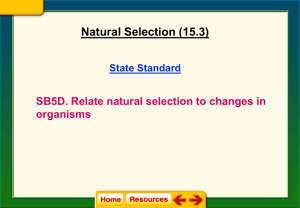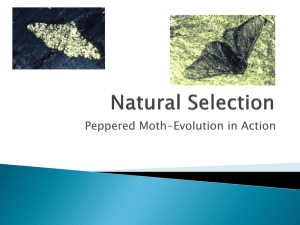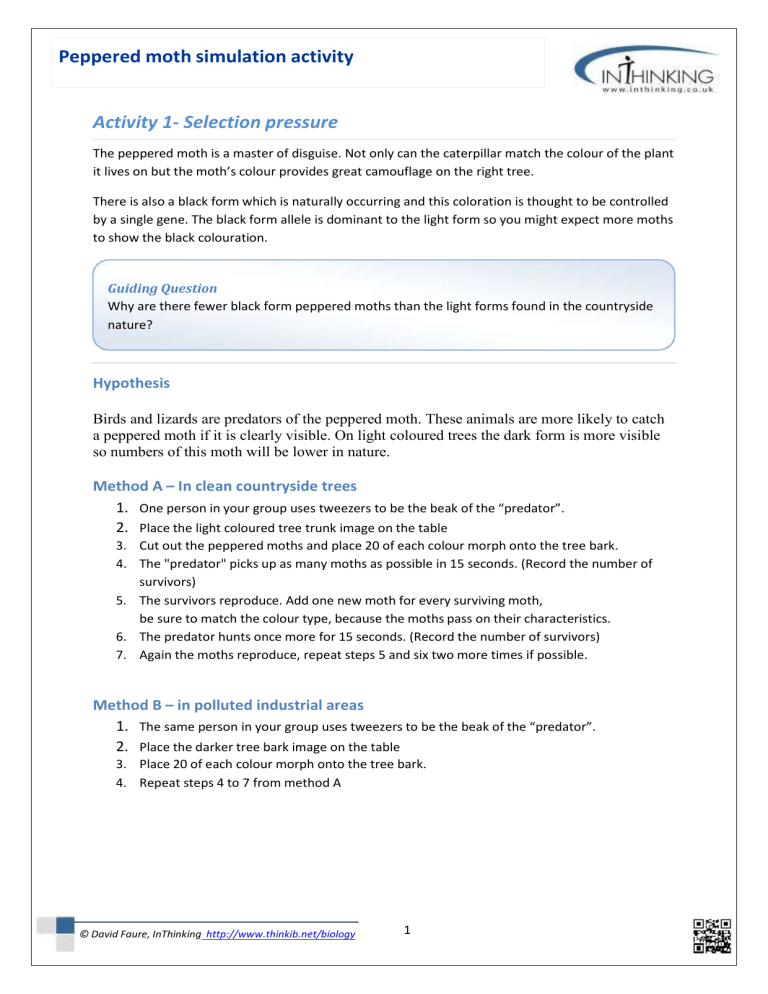
Peppered moth simulation activity Activity 1- Selection pressure The peppered moth is a master of disguise. Not only can the caterpillar match the colour of the plant it lives on but the moth’s colour provides great camouflage on the right tree. There is also a black form which is naturally occurring and this coloration is thought to be controlled by a single gene. The black form allele is dominant to the light form so you might expect more moths to show the black colouration. Guiding Question Why are there fewer black form peppered moths than the light forms found in the countryside nature? Hypothesis Birds and lizards are predators of the peppered moth. These animals are more likely to catch a peppered moth if it is clearly visible. On light coloured trees the dark form is more visible so numbers of this moth will be lower in nature. Method A – In clean countryside trees 1. One person in your group uses tweezers to be the beak of the “predator”. 2. Place the light coloured tree trunk image on the table 3. Cut out the peppered moths and place 20 of each colour morph onto the tree bark. 4. The "predator" picks up as many moths as possible in 15 seconds. (Record the number of survivors) 5. The survivors reproduce. Add one new moth for every surviving moth, be sure to match the colour type, because the moths pass on their characteristics. 6. The predator hunts once more for 15 seconds. (Record the number of survivors) 7. Again the moths reproduce, repeat steps 5 and six two more times if possible. Method B – in polluted industrial areas 1. The same person in your group uses tweezers to be the beak of the “predator”. 2. Place the darker tree bark image on the table 3. Place 20 of each colour morph onto the tree bark. 4. Repeat steps 4 to 7 from method A © David Faure, InThinking http://www.thinkib.net/biology 1 Results Generation number on light (clean) bark Number of light coloured peppered moth remaining Number of dork coloured peppered moth remaining 1 20 20 Generation number on dark (polluted) bark Number of light coloured peppered moth remaining Number of dork coloured peppered moth remaining 1 20 20 2 3 4 5 2 3 4 5 Background information on industrial melanism Around 1845 Manchester, where the first peppered moth study took place, started becoming more industrialized, black coal smoke filled the air and covered the trees. Suddenly the dark form of peppered moths an advantageous characteristic. They were harder to see on the dark tree bark. As a result the moth population showed an increase in the frequency of the alleles that dark colouration. Due to the effects of natural selection, the frequency of the allele for light gray color decreased and the frequency of the allele for dark gray color increased. 2 Questions Describe what happened to the numbers of each form of peppered moth on the light coloured bark. Compare the frequency of the light coloured peppered moths at the end of experiments on light and dark coloured tree bark. Explain how this sort of selection pressure can cause natural selection. 3 Darker tree bark – with smoke pollution which has also killed the lichens 4 Light tree bark with lichens 5 Peppered moth cut-out page Cut out the tessellated peppered moths. Cut in diagonal lines, then match the moths and cut out individual moths from several rows at a time Peppered moth cut-out page Cut out the tessellated peppered moths. Cut in diagonal lines, then match the moths and cut out individual moths from several rows at a time 6



